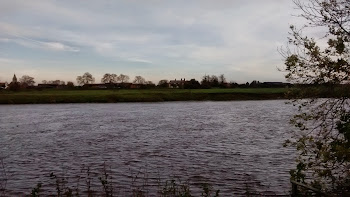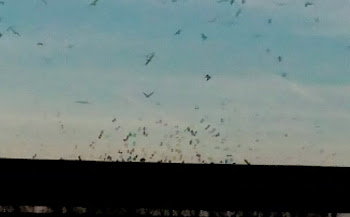Once again I am at work, and even now my fingers still feel the -4 6am cycle to work this morning. I was wearing two pairs of gloves and thus accidentally changing gear every few metres, but it still isn't preventing the familiar freezing pain from nipping at my fingertips.
Winter thrushes are appearing in numbers on the farmer's field next to the showground; impossible to confirm at this distance but they would appear to have very pale breasts and thus most likely be fieldfares. Above them gulls squabble, and occasionally a kestrel makes its way to find a favoured hunting spot around the margins, looking for any mouse not frozen into the semblance of concrete.
At least there are benefits to these freezing nights. Like two nights ago, the clearest, darkest night I have seen for a long while. The stars were glittering diamonds on their velvet display case; the Milky Way was overhead in Cassiopeia, flowing like Cleopatra's bathwater. Straddling the southern aspect, most prominent of all winter constellations, was the mighty hunter himself, Orion.
 |
| Orion from wikimedia, uploaded by Mouser |
From my garden as midnight approaches, he appears to have suddenly leapt out from behind a tree in order to shoot a terrible creature of myth, or perhaps even me. To his upper right his bow is raised, and if that isn't enough, he is wielding a club with his other hand.
Confusing overkill? Some representations have the bow as a shield, but I can't stop my brain convincing me it's a bow. After all, who hunts with a club?
However he hunts, it has certainly been successful, because in clear skies you can see the body of Lepus, the celestial hare, at his feet. The hare was present the other night, and to see it from my urban garden is all but miraculous, thus illustrating how clear the sky was.
I didn't use my binoculars; when you do, the starfields are magnificent, probably the finest you will see from the UK. There are stars everywhere, and not the faint ones associated with Cygnus and the Milky Way within; these are genuine jewels of the sky. The great nebula sits ghostlike, illuminated by the light of the searing hot iota orionis "trapezium" and the new stars forming within.
It is a beautiful view.
However, even without the binoculars there is still plenty to see and think about. The hot coal of Betelgeuse glows firey at the top left, big as 20 suns, monstrously unstable and thus variable in brightness. It is reckoned to be candidate for going supernova within a few million years, and it will be as bright as the full moon when it does.
At the opposite corner sits Rigel, a hot, blue white star that is a single to our eyes, but is actually a triple star system adding up to a whole 120,000 times more luminous than the sun. There is, of course, the nebula, still plain to the naked eye - and then the belt, the central star of which, Alnilam, is a blue-white supergiant also doomed for a supernovic ending.
It is 350,000 times more luminous than the sun, and all in all is the intrinsically brightest star you can see easily in the night sky.
After Christmas, Futurelearn are running a course on this constellation. So, why not familiarise yourself with it now, as the great hunter bestrides the night sky.




























.jpg)




















